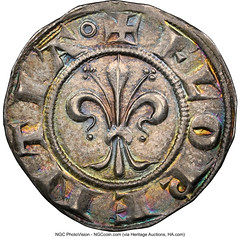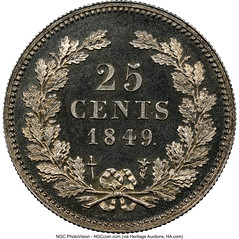
PREV ARTICLE
NEXT ARTICLE
FULL ISSUE
PREV FULL ISSUE
HERITAGE ANA WORLD & ANCIENT SELECTIONSIn a Heritage email dated August 15, 2024, catalogers offered their pick in their upcoming Signature Session of the ANA World & Ancient Coin auctions. We agree! Nice coins. -Garrett
Picks from the Signature Session of the ANA World & Ancient Coins Auction
KYLE'S PICKS
Austria: Archduke Ferdinand Charles 2 Taler ND (1646) MS62 NGC
Portraiture in the Austrian and German States Taler series advanced quite significantly from inception in the late 15th/early 16th century through the 19th century as artistic standards and technology evolved. The 1646 2 Taler of Archduke Ferdinand Charles is what I'd consider to be the apex of contemporary portraiture, rendered with great accuracy and detail. Only in mint state preservations are these types most appreciable, with the offering at hand likely to pique the interest of both the specialist and type collector.
To read the complete lot description, see:
Croatia: Zara. French Occupation Siege 18 Francs 40 Centimes (4 Ounces) 1813
Francophiles and Napoleonic history buffs will take particular interest in this Zara obsidional issue, struck during French occupation of the small but important Croatian city and fortress. During this two-week siege between Austrian and French forces in the Adriatic Campaign, emergency issues were struck with the 18 Francs 40 Centimes being the largest. The example on offer is one of the finer I've seen, punctuated by fully struck, instantly recognizable stamps to both faces, and should be considered a trophy for many.
To read the complete lot description, see:
France: Republic silver Pattern Essai 5 Francs 1848-A
From a fairly extensive series of 5 Franc patterns, struck in the first year of the Second Republic as proposed coinage for the post-monarchy government. Many pieces from this series appear a bit crude, but those from the skilled hands of the Barre family are anything but. Showcasing a mastery of design and optimism for the new Republic, this piece is just one of three witnessed by NGC in silver, and the finest, making for a rare opportunity to own an example so fine.
To read the complete lot description, see:
ALEEZA'S PICKS
Ancients: THRACE. Abdera. Ca. 375-345 BC. AR stater or tetradrachm
For my first pick, I chose this stunning Abderian tetradrachm, which features a bold griffin highlighted by its luminous surfaces. Settled by Greeks from Teos, Abdera proudly displayed their connection to their motherland through shared imagery of the powerful mythological griffin on the obverse. Conversely, the reverse designs of this issue were innovative, often depicting puns or visual plays on the names of different magistrates. The tripod depicted on this coin is likely alluding to the magistrate's name Python, linking it to Apollo and the Delphic oracle, the priestess Pythia, and the Pythian games held every four years in Delphi, where a tripod was usually awarded to the victor.
To read the complete lot description, see:
Ancients: SICILY. Camarina. Ca. 420-405 BC. AE tetras
Next, I was drawn to this magnificent Mint State, Star, and Fine Style bronze issue from Camarina, Sicily. This coin is adorned with a fearsome and dramatic image of Medusa's head facing. Her carefully rendered wild snake-like hair, tongue protruding, and wide bulging eyes make it difficult to look away; however, the artist made her eyes look slightly to the right, protecting the viewer from her stony gaze.
To read the complete lot description, see:
Ancients: Nero, as Augustus (AD 54-68). AE sestertius
And finally, while there were many contenders, I decided to pick this fantastic Fine Style and Star Nero sestertius struck on a handsome deep olive-green flan. This coin features a simplified yet detailed depiction of Nero's triumphal arch. Unlike his coins of the Temple of Janus and other examples that feature his triumphal arch, the rendering on this coin is exceptional. You can tell the artist put great effort into its quadriga, statues, and friezes, all while creating a visual balance and harmony to the piece.
To read the complete lot description, see:
THELO'S PICKS
Ancients: LUCANIA. Thurium. Ca. 443-400 BC. AR stater
More than anything, what I appreciate in a coin is a bit of personality. My favorite part of handling a coin is wondering about the people who traded it, what they bought, and—of course—who designed it. On this spectacular stater from Thurium, we get a bit of insight into the engraver in the form of a little finch just below the charging bull. HN Italy identifies the Syracusan Phrygillus as a potential identity for the engraver— "phrygilos" being the Ancient Greek word for finch. This sort of charming visual pun, known as a canting pun, brings extra life to a coin over two thousand years out of its time.
To read the complete lot description, see:
Ancients: Anonymous (ca. 225-214/2 BC). AR didrachm or quadrigatus
Next, we have a coin from what is, in my own opinion as a Classicist, one of the most interesting times in Roman history. This fiery Star quadrigatus was likely among the last didrachms minted in the Roman Republic. During the Second Punic War (218-201 BC) between Rome and Carthage, the Romans suffered devastating losses at the hands of Hannibal which caused a shortage of metal and consequently a sharp decrease in weight standards for coinage. Following this anonymous issue, there was an extreme debasement of silver coinage which was the catalyst for a brand-new system of coinage ca. 211 BC—that of the denarius, which would last for the next four centuries.
To read the complete lot description, see:
Ancients: Hadrian (AD 117-138). AR cistophorus
Finally, this exceptional Star and Fine Style Hadrian cistophorus boasts phenomenal attention to detail in the design of the octastyle temple. Despite its relatively small size, this coin nonetheless keeps every detail of the imposing ancient temples: from the miniscule figures in the pediment to the Nikes standing as acroteria. This coin is truly a marvel of ancient craftsmanship, whether it be as a tribute to those grandiose temples or as a relic of a time before modern numismatic tools.
To read the complete lot description, see:
TITA'S PICKS
Italy: Florence. Republic (1189-1532) 12 Denari ND (1189-1260)
A striking example of this 12 Denari type, the single-finest representative currently submitted to NGC. The central motifs retain impressive clarity, particularly on the obverse as John the Baptist is readily identified with his iconographic flowing hair and stylized diskos in hand. Polychromatic tone wraps around the periphery and into the crevices, adding visual spectacle to this centuries-old item.
To read the complete lot description, see:
Mexico: Charles III silver "Pachuca y Real del Monte Proclamation" Medal 1761
Attesting to the rarity and visual ingenuity of Spanish Proclamation medals, this representative if one of just a handful of its type to come to auction in recent memory and certainly among the finer examples extant. Struck for the State of Hidalgo, the reverse design harkens to certain features of its mountainous capital Pachuca and the mine Real del Monte, the coins falling from Diana's hand an obvious allusion to the mineral production of the area. A strong offering in every sense of the word, still retaining much of its original splendor with an added touch of tone on the facets.
To read the complete lot description, see:
Switzerland: Basel. Canton 2 Taler ND (c. 1670)
Absolutely enviable in hand, this weighty Cantonal 2 Taler represents the larger "City View" series admirably, exhibiting the clarity and visual comportment one expects from a near-Choice designation. Luster reverberates across the surfaces, sending ripples through the olive and orange blossom tone on either facet. Only two representatives rank higher at NGC, an opportunity here to acquire the type before it jettisons to unattainable spheres.
To read the complete lot description, see:
Picks from the Netherlands and Dutch Colonies World Coins in the Aug. 20 World Coins Showcase Auction
Netherlands: Willem III 25 Cents 1849
Few and far between are Dutch proofs of the mid-19th century, which are becoming increasingly difficult to locate recently, especially in Gem grades. On offer is an impressive 1849 25 cents of Willem III, blessed with cameo appearances and one of just 5 witnessed by certification companies. A handsome specimen from the modern Dutch series.
To read the complete lot description, see:
Netherlands: Overijssel. Provincial silver Piefort Stuiver 1739
From a series steeped in off-metal strikes and pieforts, we tend to see these in much larger denominations than the single stuivers. These issues, when brought to auction, are generally seen in gold, but rarely do we handle these Dutch minors struck on a double-thick planchet as seen here. A truly pleasing and curious emission for the specialist.
To read the complete lot description, see:
Netherlands: Breda. Siege silver Uniface Klippe 60 Stuivers 1625
This 60 Stuiver Klippe from the Siege of Breda of 1625 is an excellent example of a uniface Klippe with both a traditional circular impression displaying the arms of the United Provinces of the Netherlands as well as rather irregular counterstampings around its perimeter. Struck by Maurice of Nassau upon the besiegement of Breda by Ambrogio Spinola and his Spanish Forces, the striking material was sourced from gold and silver confiscated from the churches and townspeople of Breda in January of 1625. Breda surrendered In June 1625, and the surviving soldiers were given safe passage despite Spinola's knowledge that the Dutch had merely days left of survival. The victory marked one of the last major victories for the Spanish during the Eighty Years' War.
To read the complete lot description, see:
Netherlands: Oudewater. Siege lead Uniface 20 Stuivers 1575
This 1575 20 Stuiver from the siege of Oudewater, while in more typical circular form, was struck in a rather unconventional metal: lead. As supplies of precious metals ran out, base metals with minimal value were utilized, often stripped from monuments, churches, and public buildings; even cannons were melted down and turned into coins. This representative is a particularly rare issue, struck during the siege of Oudewater by stadtholder Gilles van Berlaymont. Eventually Oudewater was burned to the ground, and over three-fourths of its population was wiped out. Typically struck in tin, these fascinating lead examples only surface at public auction every few years, with this very same piece accounting for two of those occurrences.
To read the complete lot description, see:
Wayne Homren, Editor The Numismatic Bibliomania Society is a non-profit organization promoting numismatic literature. See our web site at coinbooks.org. To submit items for publication in The E-Sylum, write to the Editor at this address: whomren@gmail.com To subscribe go to: https://my.binhost.com/lists/listinfo/esylum All Rights Reserved. NBS Home Page Contact the NBS webmaster 
|































